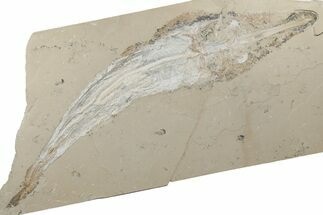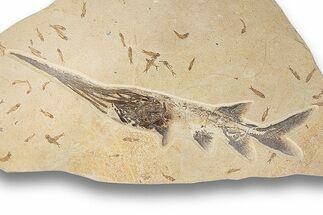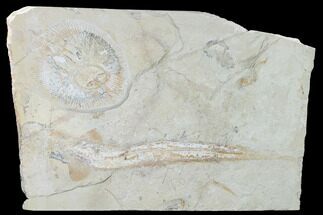This Specimen has been sold.
Rare 14" Fossil Male Stingray (Heliobatis) - Wyoming
This is a gorgeous fossil stingray (Heliobatis radians) from the Green River Formation in Wyoming. These rays are one of the more rare fossils from the Green River Formation and are highly coveted by collectors for their beauty. This 14" specimen is gorgeously preserved and nicely centered on a 20.7 x 13.5" slab of rock. Just check out the closeup photos to see the preserved detail.
This animal is a male as evinced by the presence of claspers at the base of its tail.
This ray is natural, and has not been inlaid into the rock. There are two repaired cracks through the fossil/rock with some spots of gap fill restoration along the repairs. There are a couple additional repairs along the spine where the vertebrae split onto the opposite side of the rock.
The shale has been backed with a board for stability and to make it easy to mount on a wall. Upon request, we can install a wall hanger on the back of the specimen. Otherwise it will be accompanied by a metal display stand.
Heliobatis is an extinct genus of freshwater ray primarily known from the Green River Formation in Wyoming. The teeth are triangular and shaped for feeding on small fish, crustaceans, and mollusks.
This animal is a male as evinced by the presence of claspers at the base of its tail.
This ray is natural, and has not been inlaid into the rock. There are two repaired cracks through the fossil/rock with some spots of gap fill restoration along the repairs. There are a couple additional repairs along the spine where the vertebrae split onto the opposite side of the rock.
The shale has been backed with a board for stability and to make it easy to mount on a wall. Upon request, we can install a wall hanger on the back of the specimen. Otherwise it will be accompanied by a metal display stand.
Heliobatis is an extinct genus of freshwater ray primarily known from the Green River Formation in Wyoming. The teeth are triangular and shaped for feeding on small fish, crustaceans, and mollusks.
About Fossil Lake
50 million years ago, in the Eocene epoch, these fish thrived in Fossil Lake, which was fed by the Uinta and Rocky Mountain highlands. The anoxic conditions at the bottom of Fossil Lake slowed bacterial decomposition, prevented scavengers from disturbing corpses, and, most interestingly, suffocated creatures that ventured into the oxygen-starved aquatic layer. The result is a miraculous exhibition of Eocene biota: a subtropical aquatic community within sycamore forests, teeming with creatures such as freshwater stingrays, dog-sized horses, menacing alligators, early flying bats, and one of the first primates.
50 million years ago, in the Eocene epoch, these fish thrived in Fossil Lake, which was fed by the Uinta and Rocky Mountain highlands. The anoxic conditions at the bottom of Fossil Lake slowed bacterial decomposition, prevented scavengers from disturbing corpses, and, most interestingly, suffocated creatures that ventured into the oxygen-starved aquatic layer. The result is a miraculous exhibition of Eocene biota: a subtropical aquatic community within sycamore forests, teeming with creatures such as freshwater stingrays, dog-sized horses, menacing alligators, early flying bats, and one of the first primates.
SPECIES
Heliobatis radians
LOCATION
Fossil Safari Quarry, Kemmerer, Wyoming
FORMATION
Green River Formation
SIZE
14" long on 20.7 x 13.5" rock
CATEGORY
SUB CATEGORY
ITEM
#300173
We guarantee the authenticity of all of our specimens.
 Reviews
Reviews














